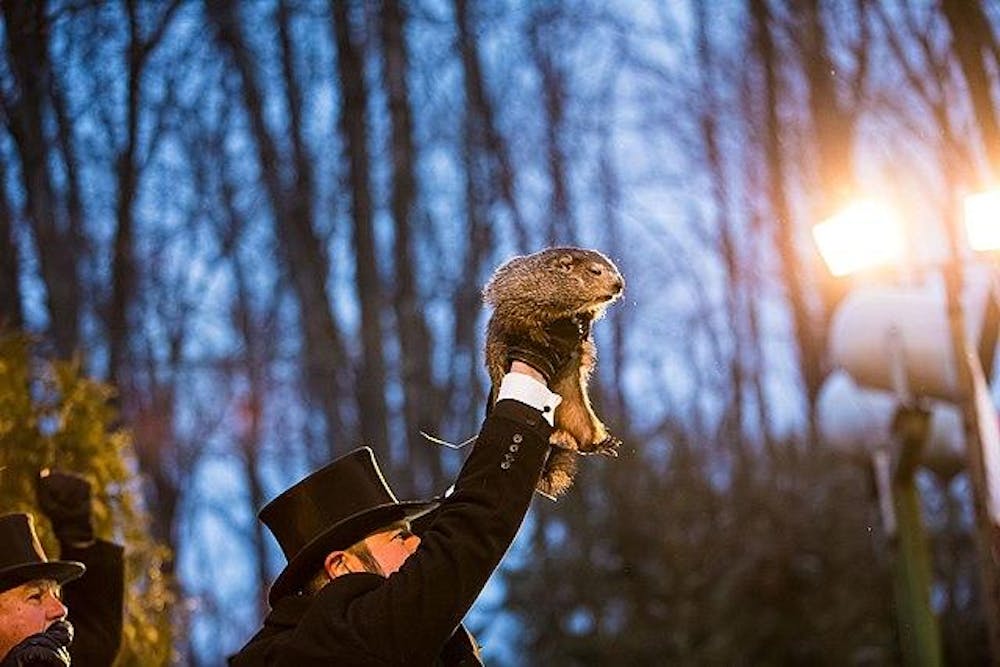On Feb. 2, attention turned briefly to the town of Punxsutawney, Pennsylvania, where the shadow of a chubby-cheeked 11-pound rodent serves as the ultimate weather forecast one day a year.
On Groundhog Day, Punxsutawney Phil — an alleged expert meteorologist — emerged from his burrow to a crowd of onlookers, all itching to see whether the woodchuck would see his shadow.
This year, Phil surfaced from his dwelling without spotting his shadow, which — according to tradition — indicated an early spring for the first time in three years. Over the course of his tenure since 1887, Phil has predicted 108 long winters and 21 early springs, with an accuracy rate of under 40%.
But as some celebrate an early spring, some on The Herald cannot help but wonder if Rhode Island even saw a winter season, which is more typically characterized by snow-capped trees, icy roads and New England Nor’easters. On Dec. 11, the temperature high in Providence was a comfortable 62 degrees – that’s sweater-and-shorts weather!
Where did winter go?
The “gold standard” of meteorological data in the state comes from the Automated Surface Observing Station at the Rhode Island T.F. Green International Airport, according to Joseph Poccia, a senior air quality specialist at the Rhode Island Department of Environmental Management.
Since 1933, there has been a slight rise in snowfall in the state, with 1945, 2015 and 2005 seeing the most snowfall at 82.3 inches, 74.3 inches and 71.3 inches, respectively.
This trend, “which is a bit surprising,” is “likely due to average winter temperatures over that 90-year span also increasing,” Poccia said.
While it might seem that warmer temperatures decrease snowfall, warmer winters are “giving the atmosphere an opportunity to hold more water vapor and possibly snow,” he added. “Average winter temperatures have been increasing, (but) they’ve still been cold enough to support an increase in snow near the surface.”
Blockbuster snowstorms have also contributed to the slight increase in average snowfall, Poccia added. He highlighted major “benchmark” storms, like the Blizzard of ’78 that brought nearly three feet of snow to Providence. Poccia also noted the prevalence of large storms in the past decade, including the 19.1-inch blizzard in 2015.
But “this is likely beginning to change,” he said. Despite a few dramatic episodes of snowfall in recent decades, snowfall over the last 30 years “has been steadily starting to decrease” due to “a definitive rise in average winter temperature.”
Over the last 30 years, rising temperatures have emerged as a consistent trend across the state.
Providence’s three warmest winters on record have all occurred since 2000 — 2015 to 2016, 2001 to 2002 and 2011 to 2012, with averages of 37.3 degrees Fahrenheit, 36.7 degrees Fahrenheit and 36.4 degrees Fahrenheit, respectively. Conversely, the three coldest winters all occurred prior to 1980.
The grinch stole Christmas — but who stole winter?
Punxsutawney Phil’s shadow may predict an early spring, but a human-to-groundhog language barrier prevents us from understanding just why he thinks winter is fading away.
It seems that “the most straightforward answer is climate change,” Poccia said.
“Since the start of the Industrial Revolution,” the earth’s population has “burned most of the fossil fuel that we've dug out of the ground,” he said. “Oil, petroleum, natural gas, coal — we've started to push the gas pedal … on the greenhouse effect, to a point where we're net warming the Earth's atmosphere.”
Rhode Island, along with greater Southern New England, is particularly susceptible to the changes driving warmer winter temperatures and decreased snowfall. “New England's winters, on average, are warming faster than the rest of the U.S.,” Poccia added, citing the United States Government's Fifth National Climate Assessment.
“It’s a product of living near the ocean,” he explained. “Since the oceans occupy such a large surface area over the planet, they absorb a lot of heat from the atmosphere, and they can hold on to that heat too.”
It’s likely that rising winter temperatures are a symptom of multiple factors. Poccia especially highlighted the jet stream weather patterns, as well as “weather coming down from Canada (and) up from the Atlantic Ocean, including tropical hurricanes.” Poccia also noted potential effects from El Nino and La Nina.
Human and environmental impact
“When things change rapidly, as our climate is now, both humans and other living things struggle to keep up with the pace of change,” Stephen Porder, associate provost for sustainability and professor of ecology, evolution and organismal biology and environment and society, wrote in an email to The Herald.
“When I moved here in 2007, I could still teach my daughter to ski in R.I. — that's not something she will be able to do with her children,” he added.
Alexandra Coia ’26 grew up in Cranston, R.I. and “vividly (remembers) there being multiple snowstorms a winter, and often a more intense blizzard mixed in,” she wrote in a message to The Herald.
“We got more than one snow day each winter and it really created great childhood memories of playing in the snow,” she added. “It barely snowed last year though — a couple of inches here and there — which takes a lot of fun out of the winter.”
The state has also seen an increase in precipitation falling as rain as opposed to snow — which can lead to flooding. Flooding “is pretty common in the winter, especially as we get towards spring,” Poccia said. “Snow enters the aquifer and the groundwater slower because it has to melt. Whereas rain can enter it a lot faster and the groundwater can sometimes become overwhelmed by that.”
Due to the rain, Rhode Island’s snowfall, however sporadic, threatens to worsen flooding in the coming years.
“When you have some big snow events there, followed by rain events, you end up obviously melting all the snow,” said Sarah Lummis, research associate in environment and society and executive director of the Community-driven Coastal Climate Research and Solutions Hub. “Then the landmass is not only dealing with the rain that's coming down, but (also) the stockpile of solid state water … to create this magnified impact of the rain.”
Warmer winters also result in a variety of ecological impacts. “Ponds, lakes, slow moving streams — if it’s a warmer winter, they're not going to have the ability to lace up and freeze,” which can affect the ecology of water bodies, leading to algae blooms, Poccia said.
Without snow covering the ground, deer and other herbivores have better access to food, adding potential overpopulation and environmental stress to the list, he said.
Can we bring snow back?
Local leaders are optimistic that scientific research, resiliency programs and environmental initiatives can slow climate change’s effects, as long as they are followed by tangible action.
“There are a lot of numbers that say things are getting warmer (and) sea levels are rising,” Lummis said. “But it doesn't really matter if we can't translate that data into livable workable solutions for communities. … Otherwise, you're just telling people that you're gonna get X amount more rain or Y amount more snow.”
Poccia noted that Rhode Island has passed statutes to slow the drivers of climate change, including a target of carbon neutrality by 2050.
“But we're such a small state,” he added. “The sheer volume of our emissions is just tiny compared to the rest of the country and the rest of the world. So we’re unfortunately going to keep telling the same kind of story … into the future, unless we make some pretty sizable progress.”
“Local efforts alone cannot slow climate change, but neither can we slow climate change without local efforts,” Porder wrote. “It will take all of us working together, at all levels.”

Tom Li is the editor-in-chief and president of The Herald's 135th editorial board. He is from Pleasanton, California and studies economics and international and public affairs. He previously served as a metro editor, covering the Health & Environment and Development & Infrastructure beats, and has worked on The Herald's copy editing, editorial page board, design and podcast teams.





